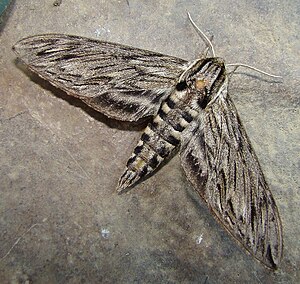Sphinx canadensis
| Sphinx canadensis | ||||||||||||
|---|---|---|---|---|---|---|---|---|---|---|---|---|

Sphinx canadensis |
||||||||||||
| Systematics | ||||||||||||
|
||||||||||||
| Scientific name | ||||||||||||
| Sphinx canadensis | ||||||||||||
| Boisduval , 1875 |
Sphinx canadensis is a butterfly ( moth ) from the family of moth (Sphingidae). The species colonizes large parts of northern North America.
features
The moths have a fore wing length of 33 to 43 millimeters. The species is difficult to determine because the pattern of the forewings is very poor in contrast. The moths are gray with a little light brown. The pattern is similar to that of several species of the genus Sphinx . Starting at the tip of the forewings, there are several short black lines between the wing veins that run across the medial region. As with other species of the genus, the two black lines near the wing tip have a white band on top. However, it is characteristic of the species that the remaining diagonal, black lines end in a pale, but easily recognizable white line near the outer edge of the wing. This white line continues at the bottom of the black lines in some individuals. The moths are only slightly variable, only the brown component of the basic color can vary. The hind wings are black on top with white bands. The species differs from Sphinx poecila by the higher proportion of brown in color and the lack of white discal spots.
The caterpillars are variable in color. There are morphs that have seven pairs of distinct, sloping, white side stripes and where the brown spots on the sides are reduced. With others, the side stripes are very weakly yellowish-green and the brown spots on the sides dominate.
The doll is almost black and has a slightly rough surface. The very short proboscis sheath is exposed and is only slightly curved away from the body, as also occurs with Sphinx sequoiae . The cremaster is broad at the base and quickly tapers to the double point.
Occurrence
The species colonizes large parts of northern North America. It occurs mainly in New England and around the Great Lakes, but is not often found there either. Around the Great Lakes, the species occurs in Michigan and Wisconsin and west to Minnesota. In the northwest of the United States, the species has been found from Maine and New York and south to northeast Pennsylvania. Several records also exist from the south of Indiana, the north of Kentucky along the Ohio River , there are isolated records from Tennessee, from Illinois along the Mississippi River as well as from the southwest Missouri, Arkansas and Nebraska. The species also occurs in northeast Alabama. In Canada, the species was found in Nova Scotia, New Brunswick, southern Québec, large parts of Ontario, and southeast Manitoba. An old record of Newfoundland is unconfirmed.
Sphinx canadensis inhabits the undergrowth of dense deciduous forests in the vicinity of wetlands.
Way of life
The moths fly to light sources, but can also be observed during twilight when they visit the flowers of Saponaria officinalis and evening primrose ( Oenothera ).
Flight and caterpillar times
The moths fly in the north of their range in midsummer. Most of the evidence is available from late June to early August. Based on the flight time, one could assume the occurrence of two generations per year, but these are probably only weather-related delays within the same generation. In Arkansas, the moths fly from May to mid-September, presumably in two generations.
Food of the caterpillars
The caterpillars have so far only been detected on black ash ( Fraxinus nigra ) that grow in the habitats described above. They were not found on these plants at other locations. It was previously believed that the species feeds on Vaccinium angustifolium , which later literature was wrongly assumed to be proven. In fact, however, there is no evidence of the species on these plants. They are also not accepted in breeding.
development
The females lay their eggs one by one on the underside of the leaves of the host plants. The caterpillars live solitary and rest on the underside of the leaves on the midrib. The caterpillars develop very quickly in captivity and are fully grown after just three weeks. Due to their color, the caterpillars are perfectly camouflaged on the leaves of the black ash that have withered at the edges in late summer. This is probably the reason why the species occurs so late in the year despite its very northern distribution. Nevertheless, the mortality of the caterpillars from parasitoids is extremely high. 80 to 90% of the caterpillars are killed by caterpillar flies. Pupation takes place in captivity in a shallow chamber in the ground; in the wild, pupation is also documented in tufts of moss that grow higher.
supporting documents
Individual evidence
- ↑ a b c d e f g h James P. Tuttle: The Hawkmoths of North America, A Natural History Study of the Sphingidae of the United States and Canada. The Wedge Entomological Research Foundation, Washington, DC 2007, ISBN 978-0-9796633-0-7 .
- ↑ a b Sphingidae of the Americas. Bill Oehlke, accessed December 29, 2011 .
literature
- James P. Tuttle: The Hawkmoths of North America, A Natural History Study of the Sphingidae of the United States and Canada. The Wedge Entomological Research Foundation, Washington, DC 2007, ISBN 978-0-9796633-0-7 .